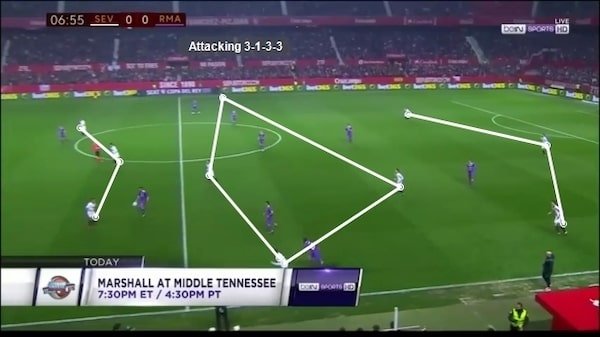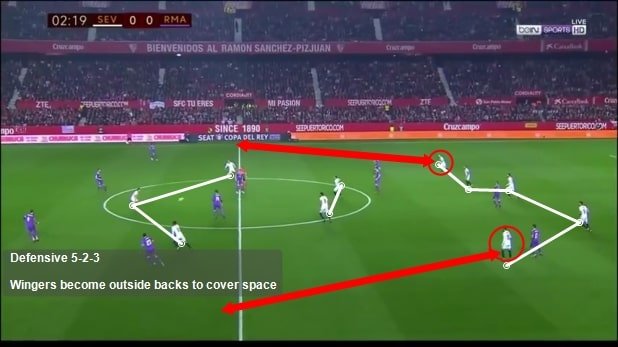Sevilla's Shapeless Form
After Sunday night’s miracle performance against Real Madrid, Sevilla’s title hopes are still alive, and now brighter than ever. Throughout the course of the year they have been brilliant to watch but Sunday night was the physical representation of what Jorge Sampaoli has been able to transmit to his players since his arrival at the beginning of this 2016-2017 season. All eleven of Sevilla’s players on the pitch, and maybe even some of the fans lucky enough to be in the stands that night, exuded what Sampaoli’s all about: heart, drive, obsession, persistence, intelligence.
As a coach I’m fascinated with Sampaoli’s tactical approach to each match, so I would like to focus on how and why he has been so successful these past few months. Of course there are many aspects which contribute to the success of a team; physical, psychological, technical, and tactical. Each of the aforementioned aspects can be divided into different segments, and within the tactical aspects I’d like to direct my attention to his formations, or shall we say the lack of formations.
Read: Crash Course to Positional Play: Part 2 of 4 - Organized Structure
Football can be summarized into a game where efficiently managing time and space results in the control of the match and increases the probability of winning. When a manager sets a formation, he deems the formation to cover as much space as possible in the least amount of time. Although throughout the course of a match, variables change and the space which must be covered also changes. Therefore, a team’s formation should have the ability to morph in order to adapt to the necessities required of the game.
Sampaoli knows this, which is why his side do not have a rigid formation. They are like water, covering all space which the game presents them, always morphing shapes making them very difficult to pinpoint. Let’s look at some of the shapes they have used in their previous of matches.
Here we can see the classic formation which in theory has been so successful for its ability to cover all space but has been critiqued for being too rigid. Depending on the match and situation, Sevilla use a back line of four, a line of three, or a line of five. In this case, the 4-4-2 gives them a compact shape to minimize space, the staggered center midfielders cut off passing lanes and break down the opposition’s ability to change the point of attack, and against this Real Sociedad side shown in the image, they create numerical superiority.
In that same match, Sevilla also used a 3-5-2, which utilizes their star defensive center midfielder, Steven N’Zonzi’s abilities to cover space and win back possession. Giving him sole responsibility of the center, allows for quick transitions into attack because they have more players waiting in the wings with space to attack. This formation requires a strong defensive midfielder like N’Zonzi.
In attack, they expand their shape to cover all space and the back line of four allows for numerical superiority in the midfield as the outside backs push up high. The center three midfielders have numerical superiority over Real Sociedad’s two central players.
In the second leg of their Copa del Rey meeting with Real Madrid, Sevilla’s attacking formation was similar to a 3-4-3 but they used a defensive central midfielder in order to control Madrid’s strong counterattack. This minor tweak to the formation resulted in the formation looking like a 3-1-3-3. However throughout the match, Madrid controlled the center of the pitch much more than Sevilla would have liked and consequently most of Sevilla’s attack came from the wings.
Defensively, Sevilla’s wingers tracked back and inserted themselves into the back line transforming them into a line of five. This formation was very defensive but with athletic and speedy wingers they were able to counter and use the wing space effectively. Their transitions were quick and didn’t require complicated movements which made them efficient.
In their league fixture against Real Madrid this past Sunday, Sampaoli put out a 4-4-2 which controlled Madrid’s organized attack for most of the encounter. The two central midfielders covered the space in the center of the pitch and were able to deny opportunities of changing the point of attack. However, the benefits of this formation could be seen in their attack. In an interview after the match, Sampaoli said he modified his team’s shape from the Copa del Rey match to be able to have more control in the middle third, by pushing the outside backs high in the midfield and advancing his wingers into the front line, ultimately creating at 2-4-4 with a wide shape.
Although on paper these modifications may seem simple and easily done, the reality is having a team who can adapt their shape so fluidly is the mark of a talented manager. Sampaoli has been able to explain the game he wants to play not through the X’s and O’s of formations but through conceptual ideas of space. When the players understand the space that the team as a whole has to cover, rather than their individual spatial responsibilities, they learn to work together, covering for each other, moving as a group, essentially, becoming one entity.
Creating this kind of symbiotic unity is far from easy but the result is a team which effortlessly moves throughout the field covering space, morphing, shifting, adapting, and always changing. Not only can it be seen in their movements but their timing, communication, and effort. Sampaoli’s created an organic machine that is ready to take on the best teams in Spain, and Europe.
How can I help you?
Coaching Positional Play Online Course: Preview the first section here
Consulting Service: Set up your first session here
4-Week Game Model Development Workshop: Sign up here
4-Week Tactical Analysis Workshop: Sign up here
4-Week Training Session Development: Sign up here
Not ready to commit: Explore our training sessions, E-Books, future webinars, and past webinars.






